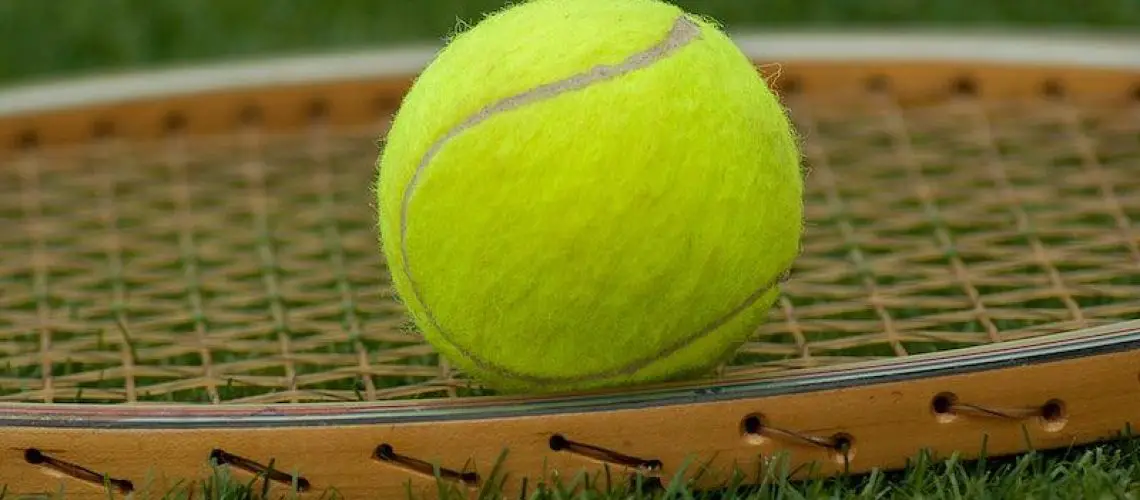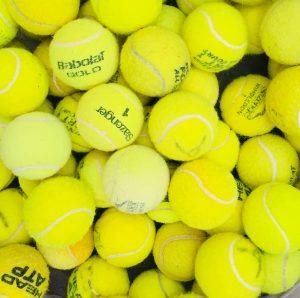We may earn money or products from the companies mentioned in this post.
Introduction

When it comes to playing tennis, having the right equipment can make all the difference in your performance on the court One often overlooked aspect of tennis gear is taping your racket While it may seem like a minor detail, taping your racket can actually have a significant impact on your game In this article, we will explore the importance of taping a tennis racket and the benefits it offers
The Benefits of Taping the Handle
One of the main areas that players choose to tape is the handle of their racket This simple yet effective technique provides several advantages during gameplay
-
Improved Grip and Comfort:
Taping the handle helps to improve grip by providing additional texture and cushioning This ensures that even during intense rallies or sweaty conditions, you can maintain a firm hold on your racket The added comfort reduces strain on your hand, allowing you to play for longer periods without discomfort or fatigue -
Enhanced Performance:
A secure grip translates into better control over shots and increased power in your swings When you have confidence in your grip, you can focus more on technique and accuracy rather than worrying about losing hold of your racket mid-swing Ultimately, this leads to improved performance and consistency on the court
The Benefits of Taping the Frame
In addition to taping the handle, many players also choose to tape their racket’s frame for added protection
-
Protection from Scuffs and Scratches:
Tennis rackets are susceptible to scuffs and scratches during gameplay due to contact with other rackets or hard surfaces like courts By applying tape along the frame, you create a protective barrier that minimizes the risk of damage This ensures your racket stays in top condition for longer -
Prolonged Lifespan of the Racket:
Taping the frame not only protects against cosmetic damage but also helps to prevent structural wear and tear The tape acts as a buffer, absorbing some of the impact during hits and reducing stress on the racket’s frame As a result, your racket can withstand more intense gameplay and last longer before needing to be replaced
In conclusion, taping your tennis racket is not just a matter of aesthetics; it offers tangible benefits that can enhance your game and prolong the lifespan of your racket By taping the handle, you improve grip and comfort while boosting performance Taping the frame provides protection from scuffs and scratches, ultimately extending the life of your racket So don’t overlook this simple yet effective technique – give your racket the care it deserves by adding some tape!
Materials needed for taping a tennis racket

Tennis, a sport that demands precision and control, requires the right equipment to enhance performance One often overlooked aspect is the tape used to secure and protect the racket Let’s explore the different types of tapes available in the market and the additional tools required for proper application
Types of tapes available in the market
When it comes to taping a tennis racket, there are two main types of tapes commonly found in stores:
-
Overgrip tape:
This type of tape is specifically designed for handle wrapping It provides an extra layer of cushioning and improves grip, allowing players to maintain control even during intense rallies Overgrip tapes come in various colors and textures, giving players the freedom to personalize their rackets while enhancing performance -
Protection tape:
As its name suggests, protection tape is used to safeguard the edges of the racket frame from wear and tear It acts as a shield against accidental impacts with other objects or surfaces, preventing damage that could affect both functionality and aesthetics
Additional tools required for proper application
To ensure a successful taping job, you’ll need a few additional tools at your disposal:
-
Scissors:
A good pair of scissors is essential for cutting precise lengths of tape without any fraying or uneven edges This ensures a neat finish and enhances overall racket appearance -
Measuring tape or ruler:
Accurate measurements are crucial when applying tapes on specific sections of your racket Using a measuring tape or ruler helps you achieve consistent positioning and alignment throughout the taping process
With these materials and tools in hand, you’re ready to transform your tennis racket into a personalized and protected piece of equipment Whether you’re looking for improved grip or added durability, taping your racket can make a significant difference in your game So, gather the necessary supplies and embark on this simple yet effective upgrade!
How to Properly Apply Tape on Your Tennis Racket Handles

Do you want to improve your grip and enhance your performance on the tennis court? Applying overgrip tape to your racket handle can make all the difference Here’s a step-by-step guide to help you achieve the perfect application
Step-by-Step Guide to Applying Overgrip Tape on the Handle
-
Measure out the length you need based on your preference
Whether you prefer a shorter or longer grip, it’s essential to measure and cut the right length of tape Keep in mind that longer lengths might add weight to your racquet, so choose wisely -
Beginning at the end cap, start winding around the handle in a diagonal direction while maintaining tension on the overgrip
This technique ensures a secure and comfortable grip during gameplay Avoid leaving any gaps between wraps as this can cause inconsistencies in grip feel -
Wrap all the way up until your desired stopping point, making sure it lies flush against the previous wrap
This ensures a smooth and seamless finish, providing optimal comfort and control while playing -
Secure the end with an included adhesive strip or by tying off with a small knot
This step is crucial for keeping the overgrip tape firmly in place throughout intense rallies and matches Double-check its stability before stepping onto the court
Common Mistakes to Avoid While Applying Overgrip Tape
-
Avoid leaving gaps between wraps:
Gaps can create uneven areas in your grip, leading to discomfort and reduced performance Ensure each wrap overlaps neatly with no spaces in between -
Don’t stretch the tape too tightly:
While maintaining tension is essential, stretching the tape excessively can result in an overly tight grip, affecting your control and feel of the racket Find a balance that suits your playing style -
Avoid overlapping too much:
Overlapping multiple layers excessively can make the handle bulky and negatively impact your grip sensitivity Experiment with single or multiple layers to find your ideal combination
Tips for Replacing Worn-Out Overgrips
If you notice signs of wear and tear on your overgrip, it’s time for a replacement Here are some useful tips:
-
Regularly inspect your overgrip:
Keep an eye out for fraying edges, loss of tackiness, or any visible damage Replacing it before it becomes completely worn-out ensures consistent performance on the court -
Clean the handle before applying a new overgrip:
Make sure to remove any dirt, sweat, or residue that may have accumulated on the handle A clean surface ensures better adhesion and longevity of the new overgrip -
Experiment with different brands and types:
Each player has unique preferences when it comes to grips Don’t be afraid to try out various options until you find one that suits your hand size, playing style, and comfort level
In conclusion, properly applying tape on your tennis racket handles is vital for achieving a comfortable and secure grip during matches By following these step-by-step instructions and avoiding common mistakes, you’ll be well-equipped to enhance your performance on the court Remember to regularly replace worn-out overgrips to maintain optimal control and improve your overall playing experience
Protecting your tennis racket frame with protection tape

Why using protection tape is important
When it comes to your beloved tennis racket, protecting its frame is crucial By applying protection tape, you can shield your racket from potential cracks and chips caused by accidental contact with the court This simple yet effective measure ensures that your racket remains in optimal condition, allowing you to play at your best without worrying about damaging the frame
In addition to safeguarding against damage, using protection tape also extends the lifespan of your racket By reducing wear and tear on the frame, the tape acts as a protective barrier that helps maintain its structural integrity over time This means you can enjoy countless hours on the court without having to constantly replace or repair your racket
Step-by-step guide to applying protection tape on the frame
- Clean the surface of your racket’s frame by removing any dirt or debris This step ensures a smooth application of the protection tape and helps in achieving a strong bond between the tape and the surface
- Measure out the length and width of tape needed for each side of the frame edge It’s important to be mindful not to cover string holes when applying the tape, as this could affect string tension and overall performance
- Gently apply the tape along the edges of the frame, smoothing it down as you go Starting at one end, work your way around the perimeter of the frame until it is fully covered By pressing firmly while smoothing down, you ensure a secure bond between the protection tape and racket surface
Maintaining and replacing worn-out protection tape
To keep your tennis racket in top shape, it’s essential to regularly inspect and maintain its protection tape Over time, the tape may begin to show signs of wear and tear, such as peeling or fraying
If you notice any damage or deterioration, it’s advisable to replace the worn-out tape promptly Removing the old tape and applying a fresh layer ensures continuous protection for your racket’s frame This simple maintenance routine will keep your racket in optimal condition and ready for intense matches on the court
Conclusion

In conclusion, taping your tennis racket offers a multitude of benefits that can greatly enhance your gameplay By providing extra grip and stability, it allows for better control and accuracy when hitting the ball The reduction in vibrations also minimizes the risk of arm injuries and fatigue, enabling you to play longer and more comfortably
However, it is important to note that the technique used in taping your racket plays a crucial role in maximizing these benefits Applying the tape correctly ensures that it adheres securely to the handle, preventing any unwanted slippage during intense rallies It also helps to maintain the tape’s longevity, ensuring it remains effective over time
With this in mind, practicing proper taping techniques regularly is highly recommended This not only allows you to become more proficient in applying the tape but also gives you an opportunity to experiment with different styles or patterns that suit your personal preferences
In summary, by consistently taping your tennis racket using correct techniques, you can prolong its lifespan while improving your overall gameplay experience So grab some tape and start perfecting those wraps – your racket will thank you!
Useful Links

Tennis Racket Grip Tape, Game On Elevate Your …
How to Overgrip a Tennis Racket | All about Tennis Grip Tape
Tennis Racket Grips | Get A Grip Tennis Grips – Get A Grip Club
What Does Lead Tape Do On A Tennis Racket?
How to Remove Lead Tape From a Tennis Racket
How and why should players apply lead tape to a frame
Best Tennis Overgrips [Reviewed & Playtested for 2023 …
Tennis Racquet Grip Tape Tennis Overgrips Colorful With
How to Put Grip Tape on a Tennis Racquet – Healthy Living
Tennis Racket Grip Tape, Tennis Overgrip …
10 Best Tennis Racket Grip Tapes For Great Comfort – 2023
Grip Tapes and Waxes : Tennis Equipment & Gear
How To Replace A Tennis Overgrip
What Are the Different Types of Tennis Grips & Grip Tape …
The Best Tennis Tape Grips for 2023
Customizing Racquet Weight & Balance
Tennis Racket Strings and Grips
Tennis Grips & Tape | Curbside Pickup Available at DICK’S






